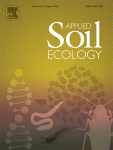Ver ítem
- xmlui.general.dspace_homeCentros e Institutos de InvestigaciónCICVyA. Centro de Investigación en Ciencias Veterinarias y AgronómicasInstituto de Microbiología y Zoología AgrícolaArtículos científicosxmlui.ArtifactBrowser.ItemViewer.trail
- Inicio
- Centros e Institutos de Investigación
- CICVyA. Centro de Investigación en Ciencias Veterinarias y Agronómicas
- Instituto de Microbiología y Zoología Agrícola
- Artículos científicos
- Ver ítem
Long-term maintenance rate fertilisation increases soil bacterial-archaeal community diversity in the subsoil and N-cycling potentials in a humid crop season
Resumen
Among agronomical practices, fertilisation greatly influences soil microbial diversity and functionality and severely disturbs the global nitrogen (N) cycle. In this study, we assessed the effect of 16 years of mineral fertilisation (NPS) on soil bacterial-archaeal communities in a no-tillage experiment in a humid climate season. We used 16S rRNA amplicon sequencing and functional prediction of marker genes involved in the N cycle at two soil depths (0–5
[ver mas...]
Among agronomical practices, fertilisation greatly influences soil microbial diversity and functionality and severely disturbs the global nitrogen (N) cycle. In this study, we assessed the effect of 16 years of mineral fertilisation (NPS) on soil bacterial-archaeal communities in a no-tillage experiment in a humid climate season. We used 16S rRNA amplicon sequencing and functional prediction of marker genes involved in the N cycle at two soil depths (0–5 and 5–10 cm). Samples were taken after soybean harvest in a wheat/soybean-maize crop sequence. At both soil depths, fertilisation increased the abundance of Proteobacteria while reducing the abundance of Verrucomicrobiota. Indicator species analyses revealed that MB-A2–108 (Actinobacteriota) and Nitrososphaeraceae (Archaea) were indicators of the low fertiliser rates at 0–5 cm. Instead, Rokubacteriales (Methylomirabilota) and Nitrolancea (Chloroflexi) were indicators of low and high rates, respectively, at 5–10 cm. Biological N–fixation genes (nifA, nifV nifHD1, and nifHD2) showed an inconsistent response depending on the soil depth. Yet, the high abundance of nifA revealed the presence of N-fixing microorganisms even at high levels of N fertilisation. The predominance of genes involved in the dissimilatory (nirB and nirK) and assimilatory (nirA) reduction of nitrate was steadily found at higher fertilisation. Given that the predecessor crop was a legume that did not receive N, our results revealed the substantial legacy of long-term N inputs on soil bacterial-archaeal diversity and N-cycling genes that might have been umpired by the current humid conditions.
[Cerrar]

Autor
Pin Viso, Natalia Daniela;
Ortiz, Jimena;
Maury, Mariana;
Frene, Juan Pablo;
Iocoli, Gastón Alejandro;
Lorenzon, Claudio Antonio;
Rivarola, Maximo Lisandro;
García, Fernando O.;
Gudelj, Vicente Jorge;
Faggioli, Valeria Soledad;
Fuente
Applied Soil Ecology 193 : 105149 (January 2024)
Fecha
2024-01
Editorial
Elsevier
ISSN
0929-1393
1873-0272
1873-0272
Documentos Relacionados
Formato
pdf
Tipo de documento
artículo
Proyectos
(ver más)
INTA/PNCYO-1127033/AR./Manejo nutricional de cereales y oleaginosas para la intensificación sustentable de los sistemas productivos
INTA/PNCER-2342/AR./Diagnóstico, Reposición de nutrientes y tecnología de fertilización
Palabras Claves
Derechos de acceso
Restringido
 Excepto donde se diga explicitamente, este item se publica bajo la siguiente descripción: Creative Commons Attribution-NonCommercial-ShareAlike 2.5 Unported (CC BY-NC-SA 2.5)
Excepto donde se diga explicitamente, este item se publica bajo la siguiente descripción: Creative Commons Attribution-NonCommercial-ShareAlike 2.5 Unported (CC BY-NC-SA 2.5)


